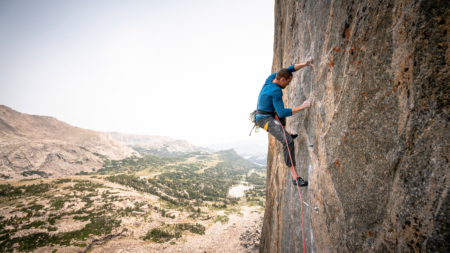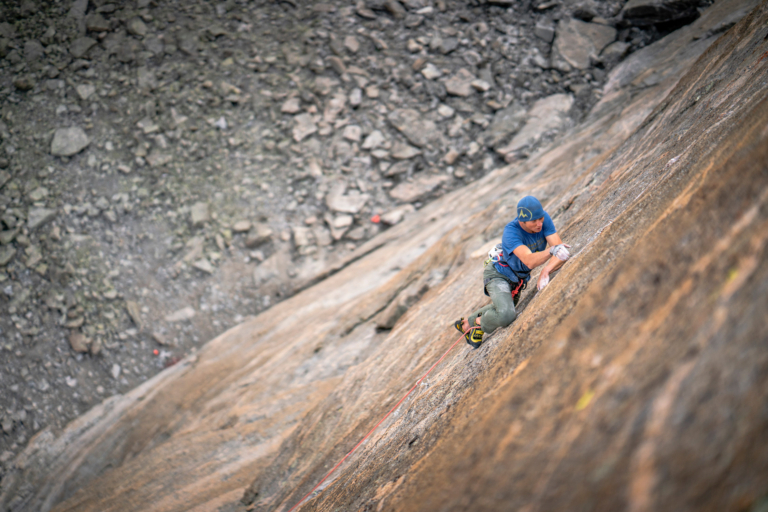Sendero Luminoso
Back to the Wind River Range.
Sendero Luminoso V 5.13d
Mount Hooker, Wind River Range, Wyoming
8/20/20
My climb definitely includes some asterisks. Asterisks in big-wall free climbing are basically commonplace these days, and really only relevant to people playing the game, and perhaps only fairly understood by those intimately familiar with the details of a particular route. However, I want to be completely honest about what I did. Apologies if this info comes off as too detailed, boring, irrelevant or self-important. But the details matter. I have two primary rules in big-wall free climbing. One, all pitches must be redpointed from legitimate ledges, aka no-hands stances. Two, prioritize being a good dad (that is, a present dad) over an asterisk-free ascent.
Although I’m satisfied with what I did, depending on one’s big-wall free climbing ethics/opinion, my ascent could be considered the second, third or fourth ascent, or it doesn’t even count.
The asterisks:
- I rehearsed the route for approximately seven climbing days on Micro Traxion, using fixed lines, before the ascent.
- I climbed with Harrison Teuber on the day of my ascent. He led pitches one through three (11b, 12b, 12c), and I led pitches four through nine (12d, 11c, 13d, 13b, 13b, 12d).
- I fell on pitch eight and redpointed it from a no-hands ledge.
- I took several falls on pitch nine and redpointed it from a no-hands ledge.
- In order to get home a day early (fixed lines through pitch 9 made rapping down, rather going up and over, much faster), I did not climb the final pitches to the summit (11b, 9, 9). I had climbed the final two 5.9 pitches on ascents of Shady Lady and Jaded Lady before.
- The Winds were lovely as usual, although a bit buggy this time of year. Off the beaten track, Mount Hooker has a 15-mile approach, so other than the odd passerby, we saw mostly no one for two weeks. The fishing is also amazing. I felt lucky to have some peaceful time away from the madness.
Legacy
In 1996, when I was 17, and an avid top roper of moss-covered slabs in southern New Hampshire, I saw an advertisement in the back of a climbing magazine for a Jackson Hole Mountain Guides “Youth Climbing Camp!” I nervously asked my dad if I could go, and since thankfully he always encouraged my passions, he flew me out to Wyoming to attend. Climbing wasn’t as popular in the ’90s as it is now, and even less so among kids, so my “Youth Climbing Camp!” turned out to have only one attendee. Me. This was a blessing in disguise. Instead of the camp experience I was expecting, I spent two blissful weeks being privately guided in the Wind River Range. In some ways that trip, more than any other, laid the foundation for a life of climbing and a particular love for rock climbing on big cliffs in the mountains.
One of my guides on the trip was Steve Quinlan. At the time, I had no idea what an accomplished climber Steve was. In 1980, Steve had made the first ascent of Sendero Luminoso on Mount Hooker, rope solo, at VI 5.11 A4. In 1980, Mount Hooker was more remote than places like Patagonia and Pakistan are today. There were no sat phones, or emergency beacons, should something go wrong, and certainly no decent weather forecasting. Gear was heavy, and unreliable, compared to today’s kits. Climbing a first ascent on a remote backcountry big wall in 1980 was, by any standard, state of the art. Doing it solo was completely badass.
Fast-forward thirty years and big-wall free climbing has become the preferred methodology among high-end climbers, arguably replacing some of the adventure and risks present in 1980, with an emphasis on physical difficulty. In 2013 Dave Allfrey, Nik Berry and Mason Earle made the second ascent of Sendero Luminoso, with the intent of creating a modern free climb. With Steve Quinlan’s permission, they replaced aging fixed gear and added bolts to several sections of the route. Over two summers, the three managed to free climb the route and establish one of the hardest and highest-quality backcountry rock routes in North America. For me, this was an inspirational ascent, but perhaps even more inspirational was Steve’s willingness to see the route become a modern, safe free climb. To let go of what must have been one of his life’s greatest adventures was a gift of kindness and selflessness. It cements his legacy and assures me that I was learning more than just climbing from him all those years ago.
Popularity
Likely as a result of travel restrictions, and a general lack of entertainment or commitments, this year was the most crowded I have ever seen in more than twenty years of trips to the Wind River Range. Hundreds of cars extended for over a mile from the Big Sandy trailhead. Mount Hooker was no different, with more climbing parties than I’d ever experienced. Like many people visiting Mount Hooker this summer, I might have mumbled begrudgingly about the “damn crowds,” but in reality, the valley below the wall absorbed people well, and everyone seemed to be treating the place with kindness and respect. If anything, the base of the wall seemed cleaner than it had when I first visited in 2009. An unexpected positive consequence of the crowds was the opportunity to meet a large number of psyched young climbers who were keen on the same sort of backcountry challenges that inspire me. Now in my 40s, with family commitments and a well-established group of partners in Colorado, I sometimes feel distanced from the next generation of climbers getting after the big, challenging routes, like those found on Mount Hooker. It was fantastic to see a large group of talented climbers breaking from the more popular pursuits of bouldering and sport climbing and to meet some new partners in the process. It also weighed on my mind just how much time I’ve spent flying to far-flung objectives, ignoring good challenges and remote areas within driving distance of my home in Estes Park. Hopefully, whenever the pandemic ends, I’ll continue to find this same level of fulfillment close to home.
Although there is a lot of hard, tricky climbing on the Sendero Luminoso, like so many big wall free climbs, the crux ultimately comes down to a fifteen foot boulder problem halfway up the wall. It’s a long walk, and quite a few pitches up, to fall off yet again. Good inspiration to give every try 110%! Photo: Drew Smith
Harrison Tueber on the crux sixth pitch of Sendero Luminoso. Harrison is soft spoken, and relatively unknown, and also one of the climbers most actively pushing hard multi pitch climbing on remote walls in North America. Getting to know Harrison, as we worked and climbed on the route together, was an unexpected treat. Photo: Drew Smith
The 5.11c, fifth pitch. One of the few pitches on the route that’s entirely gear protected, and basically unchanged since Quinlan’s first ascent. Photo: Drew Smith




